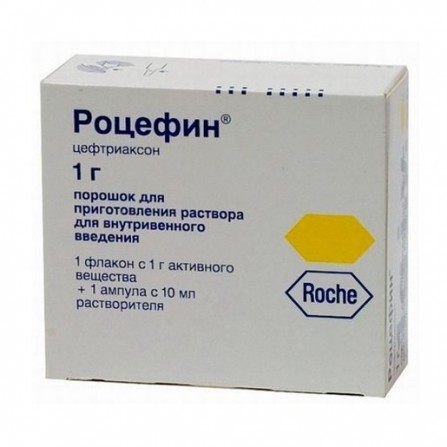Rocefin powder for preparing injection solution for intravenous administration of 1000 mg vials
Condition: New product
1000 Items
Rating:
Be the first to write a review!

More info
Active ingredients
Ceftriaxone
Release form
Solution
Composition
Active ingredient: Ceftriaxone (Ceftriaxone) Active ingredient concentration (mg): 1 g
Indications
Infections caused by pathogens that are sensitive to Rocefin: sepsis; meningitis; disseminated Lyme borreliosis (early and late stages of the disease); infections of the abdominal organs (peritonitis, infections of the biliary tract and the gastrointestinal tract); infections of bones, joints, soft tissues, skin, and wound infections; infections in immunocompromised patients; infections of the kidneys and urinary tract; infections of the respiratory tract, especially pneumonia, and infections of the upper respiratory tract; infections of the genital organs, including gonorrhea. Perioperative prevention of infections.
Contraindications
Hypersensitivity to cephalosporins.
Dosage and administration
Standard dosing regimen Adults and children over 12 years: 1-2 g once a day (every 24 hours). In severe cases or with infections, the pathogens of which have only moderate sensitivity to ceftriaxone, the daily dose can be increased to 4 g. Newborns (up to 2 weeks): 20-50 mg / kg body weight once a day. The daily dose should not exceed 50 mg / kg body weight. When determining the dose does not need to distinguish between full-term and premature babies. Infants and young children (from 15 days to 12 years): 20-80 mg / kg body weight once a day. Children weighing more than 50 kg are prescribed doses for adults. Intravenous doses of 50 mg / kg or higher should be administered drip for at least 30 minutes. Patients of senile age: usual doses for adults, without adjustments for age. The duration of treatment depends on the course of the disease. As is always the case with antibiotic therapy, administration of Rocefin should be continued in patients for at least 48-72 hours after normalization of temperature and confirmation of eradication of the pathogen.
Side effects
The following side effects have been observed with Rocefin, which disappeared either alone or after discontinuation of the drug: Gastrointestinal tract (about 2%): soft stools or diarrhea, nausea, vomiting, stomatitis, glossitis, taste disorder (less than 1%). Hematological changes (about 2%): eosinophilia, leukopenia; less often (less than 1%): granulocytopenia, hemolytic anemia, thrombocytosis, thrombocytopenia, increased thromboplastin iprothrombin time.Separate cases of agranulocytosis (less than 500 cells / mcl) are described, most of which developed after 10 days of treatment and the use of a cumulative dose of 20 g or more. Skin reactions (about 1%): rash, allergic dermatitis, pruritus, urticaria, edema. Individual cases of severe adverse reactions (exudative erythema multiforme (Stevens-Johnson syndrome), toxic epidermal necrolysis (Lyell's syndrome)). Others (rarely observed): headache and dizziness, precipitation of calcium salts of ceftriaxa in the local bladder with appropriate symptoms, pancreatitis, increased activity of hepatic enzymes (ALT ACT), ALP, hyperfilirubinemia, oliguria, increased serum creatinine concentration, mycoses, mycozymes, myemoses, hyperbilirubinemia, oliguria, increase in serum creatinine concentration, mycoses, mycozymes, hyperbilirubinemia, oliguria, increase in serum creatinine concentration, mycoses, mycoplasma, mycosis, hyperbilirubinemia, oliguria, increased serum creatinine concentration, mycozyme, elevation of serum, mikozy sweating, hot flashes, allergic pneumonitis, bronchospasm, nosebleeds, hematuria, jaundice, reduction of prothrombin time, seizure, palpitations, syvoro accurate disease, as well as anaphylactic or anaphylactoid reactions. less rarely Very rare cases of pseudomembranous colitis (less than 0.01%) and blood clotting disorders, as well as kidney stones, mainly in children older than 3 years who received either large daily doses (more than 80mg / kg daily) or cumulative doses of more than 10 g have been described. , as well as having additional risk factors (limiting fluid intake, bed rest, etc.). The formation of calculi in the kidneys can occur without symptoms or manifest clinically, can lead to renal failure and reversible after cessation of therapy with Rocefin. Local reactions (very rare): phlebitis after intravenous administration. It can be avoided by injecting the drug slowly over a period of 2-4 minutes. Intramuscular injection without lidocaine is painful.


